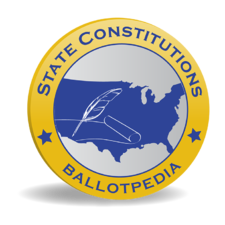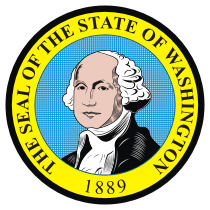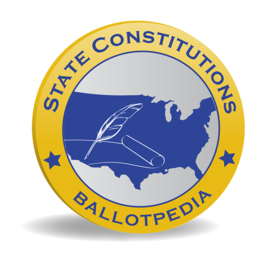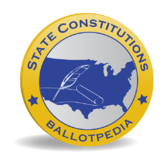Washington Constitution
| Washington Constitution |
|---|

|
| Articles |
| I • II • III • IV • V • VI • VII • VIII • IX • X • XI • XII • XIII • XIV • XV • XVI • XVII • XVIII • XIX • XX • XXI • XXII • XXIII • XXIV • XXV • XXVI • XXVII • XXVIII • XXIX • XXX • XXXI • XXXII |
| Amendments |
The Washington Constitution is the state constitution of Washington.
- The current Washington Constitution was adopted in 1889.
- Washington has had two state constitutions.
- The current state constitution has 32 articles.
- The current Washington Constitution has been amended 109 times.[1][2]
- Voters last approved new amendments to the Washington Constitution on November 3, 2020, when voters approved Senate Joint Resolution 8212.
The Washington Constitution can be amended with a legislative or covention-referred constitutional amendment, both of which require voter approval.
A state constitution is the fundamental document that outlines a state's framework for governance, including the powers, structure, and limitations of the state government, individual and civil rights, and other matters.
Background
Washington became the 42nd state on November 11, 1889. The state's first constitution was ratified in 1878 and lasted until the current version was ratified in 1889.[3][4]
The second constitutional convention met in Olympia, Washington, from July 4 to August 22, 1889, where 75 delegates helped draft the constitution which was ratified on October 1, 1889. President Harrison issued a proclamation admitting Washington to the Union on November 11, 1889.[3]
Preamble
- See also: Preambles to state constitutions
The preamble of the Washington State Constitution states:
Article I
- See also: Article I, Washington State Constitution
Article I of the Washington State Constitution is labeled "Declaration of Rights." It includes 35 sections and lays out a variety of fundamental citizen rights in the state, covering topics such as the rights of petition and assembly, freedom of speech, the rights of the accused and the rights of crime victims, religious freedom, habeas corpus, eminent domain, the right to bear arms and the right of recall.
Click here to read this article of the Washington State Constitution.
Article II
Article II of the Washington State Constitution is labeled "Legislative Department." Article II details the workings of the legislative branch of Washington's state government and includes 43 sections.
Click here to read this article of the Washington State Constitution.
Article III
Article III of the Washington State Constitution is labeled "The Executive." It has 25 sections which define the duties, rights and prerogatives of the office of the Governor of Washington and other statewide constitutional officers.
Click here to read this article of the Washington State Constitution.
Article IV
Article IV of the Washington State Constitution is labeled "The Judiciary" and has 31 sections. It establishes the powers, rights and obligations of the state's courts and judges.
Click here to read this article of the Washington State Constitution.
Article V
- See also: Article V, Washington State Constitution
Article V of the Washington State Constitution is labeled "Impeachment" and describes the impeachment process.
Click here to read this article of the Washington State Constitution.
Article VI
Article VI of the Washington State Constitution is labeled "Elections and Elective Rights." It describes voter qualifications, who can be disqualified, residency requirements for voting in particular areas, the "privilege from arrest" enjoyed under certain voting circumstances, the legislature's obligation to create a voter registration system and when elections are to be held.
Click here to read this article of the Washington State Constitution.
Article VII
Article VII is entitled "Revenue and Taxation." According to The Washington State Constitution: A Reference Guide, Article VII was passed with little debate by the constitutional convention that led to the 1889 constitution.
Click here to read this article of the Washington State Constitution.
Article VIII
Article VIII of the Washington State Constitution is labeled "State, County, and Municipal Indebtedness." It includes 11 sections.
Click here to read this article of the Washington State Constitution.
Article IX

Photo credit: Washington Secretary of State's office
Article IX of the Washington State Constitution is labeled "Education." It includes sections 1-5 for a total of five sections. According to Utter and Spitzer (2002), the paramount duty language in Section 1 is some of the strongest language in any state constitution governing the duty of a state to guarantee the education "of all children residing within its borders."[6]
Click here to read this article of the Washington State Constitution.
Article X
- See also: Article X, Washington State Constitution
Article X of the Washington State Constitution is labeled "Militia." It includes six sections. It defines "all able-bodied male citizens of this state between the ages of eighteen (18) and forty-five (45) years except such as are exempt by laws of the United States or by the laws of this state" as being "liable to military duty." It does allow room for conscientious objection, but only during times of peace and after making a payment for their exemption: "No person or persons, having conscientious scruples against bearing arms, shall be compelled to do militia duty in time of peace: Provided, such person or persons shall pay an equivalent for such exemption."[5]
Click here to read this article of the Washington State Constitution.
Article XI
Article XI of the Washington State Constitution is labeled "County, City, And Township Organization." It includes 16 sections.
Click here to read this article of the Washington State Constitution.
Article XII
Article XII of the Washington State Constitution is labeled "Corporations other than Municipal." It includes 22 sections.
Click here to read this article of the Washington State Constitution.
Article XIII
Article XIII is labeled "State Institutions." The state institutions it addresses are educational, reformatory and penal institutions.
Click here to read this article of the Washington State Constitution.
Article XIV
Article XIV of the Washington State Constitution is labeled "Seat of Government." It includes three sections. It established that the location of the seat of government cannot be determined by the Washington State Legislature but instead, must be determined by a statewide vote of the people. Once the initial decision about where to locate the seat of government was made, this Article says that it can only be changed in the future by a 2/3rds supermajority vote, except in the case of an emergency as defined in Section 42 of Article II.[5]
Click here to read this article of the Washington State Constitution.
Article XV
Article XV of the Washington State Constitution is labeled "Harbors and Tide Waters." It includes three sections.
Click here to read this article of the Washington State Constitution.
Article XVI
Article XVI of the Washington State Constitution is labeled "School and Granted Lands." It includes six sections.
Click here to read this article of the Washington State Constitution.
Article XVII
Article XVII of the Washington State Constitution is labeled "Tide Lands." It includes two sections. In this article, the State of Washington "asserts its ownership to the beds and shores of all navigable waters in the state up to and including the line of ordinary high tide, in waters where the tide ebbs and flows, and up to and including the line of ordinary high water within the banks of all navigable rivers and lakes."[5]
Click here to read this article of the Washington State Constitution.
Article XVIII

Article XVIII of the Washington State Constitution is labeled "State Seal" and has one section.
Click here to read this article of the Washington State Constitution.
Article XIX
Article XIX of the Washington State Constitution is labeled "Exemptions." It has one section which states, "The legislature shall protect by law from forced sale a certain portion of the homestead and other property of all heads of families."[5]
Click here to read this article of the Washington State Constitution.
Article XX
Article XX of the Washington State Constitution is labeled "Public Health and Vital Statistics." It has two sections.
Click here to read this article of the Washington State Constitution.
Article XXI
Article XXI of the Washington State Constitution is labeled "Water and Water Rights" and has one section.
Click here to read this article of the Washington State Constitution.
Article XXII
Article XXII of the Washington State Constitution is labeled "Legislative Apportionment." It has two sections.
Click here to read this article of the Washington State Constitution.
Article XXIII
Article XXIII of the Washington State Constitution is labeled "Amendments." It includes three sections. Its three sections describe the process of amending the state constitution through legislatively referred constitutional amendments and the process of bringing together a state constitutional convention.
Click here to read this article of the Washington State Constitution.
Article XXIV

Article XXIV of the Washington State Constitution is labeled "Boundaries" and has one section.
Click here to read this article of the Washington State Constitution.
Article XXV
Article XXV of the Washington State Constitution is labeled "Jurisdiction." It has one section and describes how the federal government can have political jurisdiction over tracts of land that lay within the territorial boundaries of the State of Washington.
Click here to read this article of the Washington State Constitution.
Article XXVI
Article XXVI of the Washington State Constitution is labeled "Compact with the United States." It is not subdivided into sections as most articles are. It details the compact made between the State of Washington and the U.S. Government. It begins with, "The following ordinance shall be irrevocable without the consent of the United States and the people of this state."[5]
Click here to read this article of the Washington State Constitution.
Article XXVII
Article XXVII of the Washington State Constitution is labeled "Schedule." It includes 19 sections, each of which lays out various details of the transaction as the State of Washington transformed from a territory under the control of the U.S. federal government, to being its own state.
Click here to read this article of the Washington State Constitution.
Article XXVIII
Article XXVIII of the Washington State Constitution is labeled "Compensation of State Officers" and has one section.
Click here to read this article of the Washington State Constitution.
Article XXIX
Article XXIX of the Washington State Constitution is labeled "Investments of Public Pension and Retirement Funds." It has one section and details how public pension and retirement funds may be invested.
Click here to read this article of the Washington State Constitution.
Article XXX
Article XXX of the Washington State Constitution is labeled "Compensation of Public Officers," and has one section.
Click here to read this article of the Washington State Constitution.
Article XXXI
Article XXXI of the Washington State Constitution is labeled "Sex Equality - Rights and Responsibilities." It includes two sections.
Click here to read this article of the Washington State Constitution.
Article XXXII
Article XXXII of the Washington State Constitution is labeled "Special Revenue Financing" and has one section.
Click here to read this article of the Washington State Constitution.
Amending the Washington constitution
- See also: Article XXIII, Washington State Constitution, The Washington Constitution provides two mechanisms for amending the state's constitution— a legislative process, and a state constitutional convention. Washington requires a simple majority vote (50% plus 1) for voters to approve constitutional amendments.
Legislature
According to Article XXIII, the state Legislature can refer constitutional amendments to the ballot for voters to decide. In Washington, a referred constitutional amendment requires a two-thirds (66.67%) vote in each chamber of the Washington State Legislature during one legislative session. That amounts to a minimum of 66 votes in the Washington House of Representatives and 33 votes in the Washington State Senate, assuming no vacancies. Amendments do not require the governor's signature to be referred to the ballot.
Convention
According to Article XXIII of the Washington State Constitution, a two-thirds (66.67%) vote is required during one legislative session for the Washington State Legislature to place a constitutional convention question on the ballot. If a simple majority of voters approve the question, then the legislature needs to call for a convention during its next session.
The Washington Constitution provides two mechanisms for amending the state's constitution— a legislative process, and a state constitutional convention. Washington requires a simple majority vote (50% plus 1) for voters to approve constitutional amendments.
Legislature
According to Article XXIII, the state Legislature can refer constitutional amendments to the ballot for voters to decide. In Washington, a referred constitutional amendment requires a two-thirds (66.67%) vote in each chamber of the Washington State Legislature during one legislative session. That amounts to a minimum of 66 votes in the Washington House of Representatives and 33 votes in the Washington State Senate, assuming no vacancies. Amendments do not require the governor's signature to be referred to the ballot.
Convention
According to Article XXIII of the Washington State Constitution, a two-thirds (66.67%) vote is required during one legislative session for the Washington State Legislature to place a constitutional convention question on the ballot. If a simple majority of voters approve the question, then the legislature needs to call for a convention during its next session.
See also
- State constitution
- Constitutional article
- Constitutional amendment
- Constitutional revision
- Constitutional convention
- Amendments
External links
Footnotes
- ↑ Washington Secretary of State, "Constitutional Amendment Ballot Measures," accessed November 25, 2023
- ↑ University of Washington School of Law, "Washington State Constitutional Amendments," accessed November 25, 2023
- ↑ 3.0 3.1 Washington Secretary of State, "Washington State Constitution," accessed November 25, 2023
- ↑ Steinglass, S., et al. (2022). The Washington State Constitution. New York, NY: Oxford University Press
- ↑ 5.0 5.1 5.2 5.3 5.4 5.5 Washington State Legislature, "Washington Constitution," accessed March 30, 2014
- ↑ Utter, Robert F. and Hugh D. Spitzer. (2002). The Washington State Constitution: A Reference Guide, Westport, Connecticut: Greenwood Press
| |||||
State of Washington Olympia (capital) | |
|---|---|
| Elections |
What's on my ballot? | Elections in 2024 | How to vote | How to run for office | Ballot measures |
| Government |
Who represents me? | U.S. President | U.S. Congress | Federal courts | State executives | State legislature | State and local courts | Counties | Cities | School districts | Public policy |


